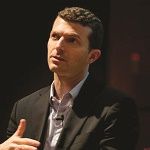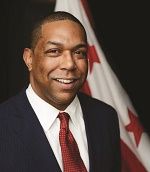This is your first of three free stories this month. Become a free or sustaining member to read unlimited articles, webinars and ebooks.
Become A Member
EDITOR’S NOTE: This piece was originally published in Next City’s commemorative print issue, called “15 Solutions for Cities.”
ALLISON ARIEFF
Editorial Director, SPUR; Next City Board Member: Anne Hidalgo, mayor of Paris, is fighting hard to keep Paris streets car-free. Her proposal to take more than three kilometers of one of the most beautiful stretches of urban waterway in the world and
reserve it for the exclusive use of pedestrians and cyclists was approved in October after an epic battle. New trees will be planted, more green space allotted, green roofs installed, CO2 emissions mitigated. Mayor Hidalgo’s efforts to create a greener city, to model for others how a city attuned to climate change should work, is inspirational. We need more leaders like her.
ELLIS CARR
President and CEO, Capital Impact Partners: I am enthusiastic about organizations that not only provide services to communities, but that redefine what nonprofits can do to support their community.
Martha’s Table has redoubled the effort to reverse some of the stubborn and systemic inequities that persist in Washington, D.C. After 35 years, the organization relocated to the heart of the city to stand shoulder to shoulder with their new neighbors to develop better integrated and more accessible support systems like their Strong by 8 strategy, working to advance childhood development.
DON CHEN
President, Surdna Foundation: What gives me hope? The rise and power of low-wealth and marginalized people making urban development decisions, generating results for their communities and greater accountability for all. In October, a founder of the world’s slumdweller movement, Jockin Arputham, passed away. But his impact lives on in participatory planning processes, sometimes led by government, and often sparked by residents. I’m encouraged that foundations have thrown their weight behind similar initiatives such as
The Amplify Fund, focusing on urban development, the
NDN Collective, formed by Native-American organizations, and
For Freedoms, a hub for engaged artists.
COLIN COOP
Design Partner, Skidmore, Owings & Merrill: One of the most important parts of teaching is how you communicate the lesson. This is what
CUP (Center for Urban Pedagogy) has been perfecting for more than 15 years. CUP educates urban populations about how policies impact their cities. Team leaders engage with artists, designers and communities of all ages and backgrounds to steer the group toward a goal, using fun, informative activities. Each initiative results in some form of visual communication that, in turn, becomes a tool distributed throughout NYC to clearly explain the issue. The future of our cities will only be brighter through this organization’s efforts to create a better-informed and empowered public.
SHAWN ESCOFFERY
Executive Director, Roy and Patricia Disney Family Foundation: Progressive policies and grassroots efforts pushing for change, innovation and accountabilities are necessary to ensure a brighter future for evolving cities. But the cornerstones to a successful future are diverse decisionmaking bodies that reflect all communities — especially groups that have been historically underappreciated. Programs such as Urban Habitat’s
Boards and Commissions Leadership Institute work to diversify planning commissions, community boards, city councils and other offices by training community members and inspiring unlikely leaders. A diversity of voices and experiences will lead to more informed urban planning decisions.
CONNIE EVANS
President and CEO, Association for Enterprise Opportunity: Memphis-based
The 800 Initiative is a brilliant path for equitable urbanization. Under Mayor Jim Strickland, this initiative will create opportunities for minority entrepreneurs to compete in the local economy by increasing revenue for 800 urban minority-owned businesses by $50 million in five years. This is the type of innovation that AEO has similarly championed through our own Tapestry Project, which harnesses the power of partnerships to create and scale products and services that can be used to support black-owned businesses. I’m excited to see how The 800 Initiative will position minority-owned businesses to benefit from urban economic development.
RODNEY FOXWORTH
Executive Director, Business Alliance for Local Living Economies (BALLE): If economic trends persist, median African-American household wealth will fall to zero by 2053. Latinx households are on a similar trajectory. The United States will be majority person of color by 2050. What will become of American cities if the majority of its citizens have little to no wealth? Thankfully, innovative women of color such as
Jessica Norwood,
Nwamaka Agbo,
Alfa Demmellash, and
Kesha Cash and Stefanie Thomas are leading a movement toward an economy grounded in equity and democratization of capital. Our future depends on the brilliance, courage and leadership of women of color.
ADAM GORDON
Associate Director and Staff Attorney, Fair Share Housing Center; Next City Co-Founder: Fifty years ago, Congress passed the Fair Housing Act. Recently we have seen a dramatic upswell of grassroots organizational action, in recognition that communities are still not free from racial discrimination and enforced segregation. Much of what doesn’t work in cities and suburbs — high housing costs, dysfunctional land use patterns, differing educational and economic outcomes by race — reflects the failure to address these inequities. From the
Right to the City organizing movement to the landmark efforts to advance fair housing happening in several states, we have started to see change. That gives me hope for realizing the more just and equitable world that those of us who founded Next City wanted to help build.
BRUCE KATZ
Director, Nowak Metro Finance Lab, Drexel; Next City Board Member: The growth of cities requires the evolution of urban institutions. The public asset corporation model exemplified by
Copenhagen’s City & Port Development Corporation and Hamburg’s HafenCity represents a proven institutional vehicle for spurring the large-scale regeneration of a key part of a city and capturing a portion of the value appreciation that naturally results for long-term public benefit. This model represents a vehicle for both spurring smart, sustainable development as well as growing public wealth that can be deployed for key urban investments.
ANIKA SINGH LEMAR
Clinical Associate Professor of Law, Yale Law School; Next City Co-Founder: Two organizations in my own city, New Haven, promote inclusive entrepreneurship, helping businesspeople (low-income people, mothers, immigrants) who face the highest barriers to entry.
All Our Kin, Inc. empowers home day care providers and helps them provide high-quality early childhood education. A few blocks away,
CitySeed, Inc.’s Sanctuary Kitchen hires immigrants and refugees to share their cultural traditions through cooking classes, catering and supper clubs. Both organizations seek to dismantle regulatory barriers — from oppressive zoning to redundant food preparation regulations — faced by the businesses they support.
DIANA LIND
Former Editor in Chief/Executive Director, Next City; Author of the forthcoming book, “Brave New Home:” Over the past 15 years, many American cities have witnessed neighborhoods swing from disinvestment to over-gentrification, rarely experiencing a steady growth. We need programs and policies that make it easier for all residents to guide and benefit from a neighborhood’s natural evolution. We’ve created a series of housing policies, zoning codes and tax benefits that exacerbate inequality, racial segregation, educational disparities and unhealthy lifestyles. Cities should look beyond construction incentives and subsidies, which only address housing cost. Instead, explore how new housing types such as shared living, multigenerational living, micro-apartments and accessory dwelling units can help achieve a city’s broadest social, economic and environmental goals.
LIZ OGBU
Founder and Principal, Studio O; Vanguard 2012; From Paper Monuments to Design as Protest,
Sue Mobley and Bryan Lee of Colloqate Design, in New Orleans, create projects and programs that use critical conversations around power, privilege and equity as organizing principles for how we should be thinking of the practice of design and the things we design. I appreciate that they approach design with a community organizing lens. It speaks not only to the need for those most impacted to be centered as agents of change; it also acknowledges that our cities can only become equitable if we work from a place of collective, intersectional power. Design and designers should be a part of this conversation, but rarely are. Fortunately, Sue and Bryan are helping to lead the way.
CASIUS PEALER
Director of Sustainable Real Estate Development, Tulane School of Architecture; Next City Board Vice Chair: Vote16USA lobbies to lower the voting age as a way to strengthen democracy. They believe younger citizens voting in local elections will improve turnout, spur engagement and encourage civic education. When 16- and 17-year-olds can vote, they tend to vote in higher percentages than older voters. Only a handful of U.S. states allow local governments to set the voting age without state legislative action. A bill before the Washington, D.C., city council would enfranchise more than 10,000 youth (nearly 80 percent of them youth of color) and make D.C. the largest U.S. city to allow a youth vote.
JEFF RISOM
Partner & Chief Innovation Officer, Gehl: The city of San Jose has put
Public Life on the agenda at every level of government, from top city staff to citizens. Public Life is what people create when they live their lives, alone and together, in public spaces. It has been adopted as one of the seven “enterprise goals” of the City, integrated into the daily operations of government overseeing public works, parks, culture, transportation and economic development. A coalition of more than 100 city staff has been trained to work across departments to prioritize Public Life in each of their portfolios with success criteria that no single department can achieve on its own, a strategy known as “collaborative accountability.”
JASON SCHUPBACH
Director, Herberger Institute for Design and the Arts, Arizona State University; Next City Board Member: Liz Ogbu is a hero of mine. Her deep social justice work around housing and transit issues in the Bay Area and Virginia, in partnership with Christine Gaspar, Barbara Brown Wilson and others, is something we should all emulate. She’s often one of the only African-American women in the rooms of power when cities are discussed. Hence, I’m most excited to see more people of color rising to positions of power. Liz, Toni Griffin, Justin Garrett Moore, Lynn Ross, Bryan Lee and others are pushing the design and community-development fields to improve their practices.
DENISE SCOTT
Executive Vice President for Programs, Local Initiatives Support Corporation: Innovation isn’t just about program design and financial structuring; it’s about new collaborations that fuel economic opportunity. Look at
LIVE Denver, a pilot that connects public agencies, employers and nonprofits to leverage the city’s glut of vacant upscale housing and address the needs of rent-burdened families — all while supporting economic growth. These types of initiatives make the case, especially to new impact investors, that traditionally overlooked communities are, in fact, good places to live, work, do business and raise families.
TAMAR SHAPIRO
Non-Resident Fellow, Urban Institute; Next City Board Member: Rapid urbanization characterizes cities in much of the world. Yet many cities are experiencing population loss and disinvestment. This number will likely grow, given demographic trends in industrialized countries. No silver bullet can address urban decline. I am encouraged by many revitalization efforts: the expansion of
land banking as a tool to return vacant properties to productive use; the increased interest in urban greening for its social and environmental benefits; and the work to ensure that revitalization is community-driven, for example through cooperative models, land trusts and community organizing. I hope that residents and leaders of cities facing decline will together build strong, vibrant, diverse neighborhoods using these and other approaches.
ERIC SHAW
Next City Board Chair; Former Director, D.C. Office of Planning; Vanguard 2013: The
Los Angeles Urban Renewal Network (LURN) and their executive director, Rudy Espinoza, advance social justice, create economic opportunity and mobilize the marginalized to be change agents. LURN approaches advocacy at a grassroots level, but also amplifies and sustains its victories by connecting to capital, thought leaders and policymakers. From successful efforts to legalize street vending, reclaim public and private space for children and families, and create new financing and distribution mechanisms to increase healthy food access, LURN is making a difference.
JESS ZIMBABWE
Director of Urban Development & Leadership, National League of Cities; Next City Board Chair Emeritus: Accessory dwelling units — basement apartments, garage conversions and backyard cottages — are becoming public policy.
California has led the way with reforms that make it easier to address parking requirements, permitting processes and design requirements. This flexible model not only adds housing stock, it creates infill density in neighborhoods where new residents are likely to walk, bike or use other less carbon-intensive transportation. Those new residents can add age, class, race and family-type diversity to neighborhoods. If cities prove anything, it’s that we are all better for living together.



















